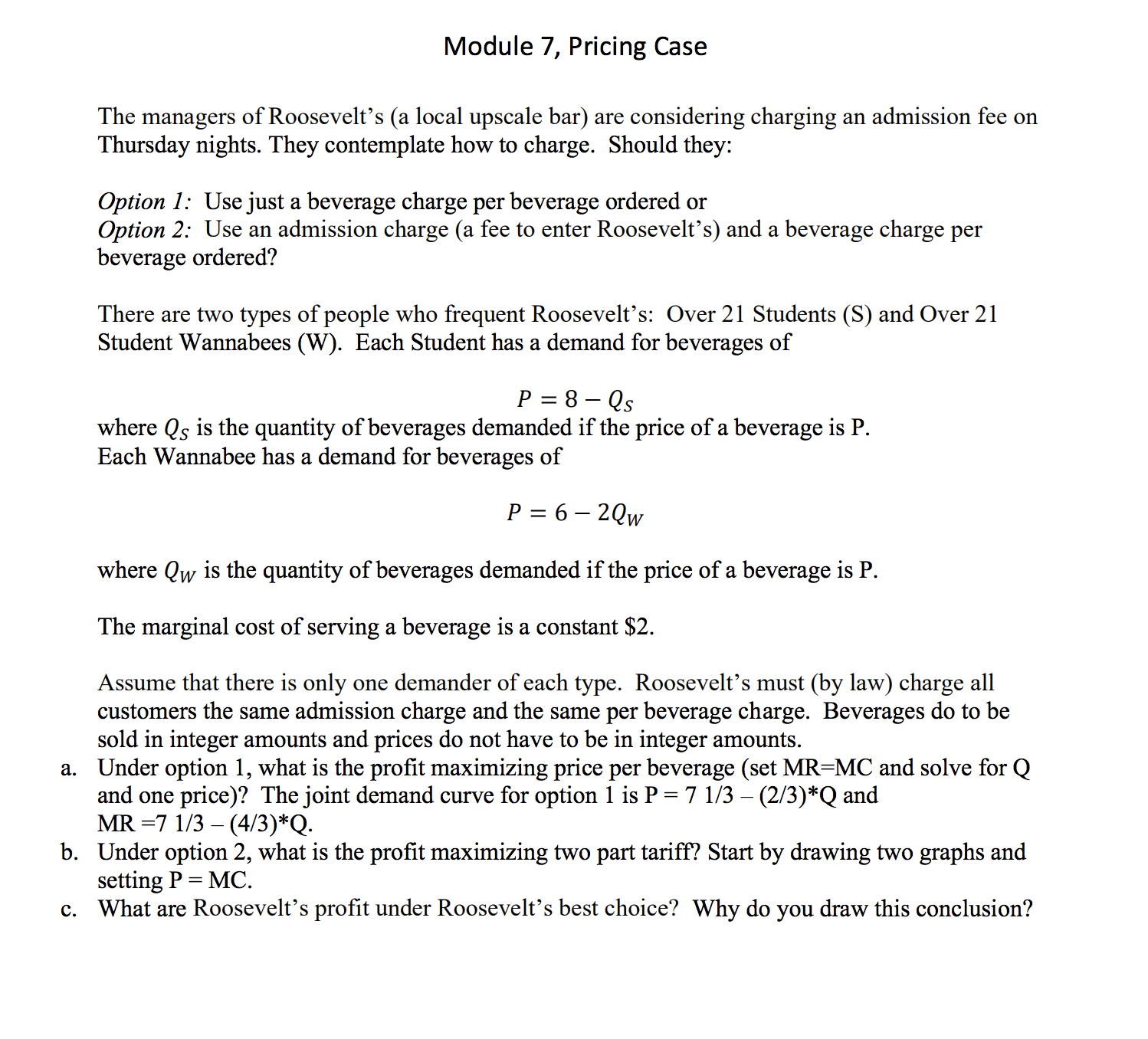Module 7, Pricing Case The managers of Roosevelt's (a local upscale bar) Thursday nights. They contemplate how to charge. Should they: are considering charging an admission fee on S Option 1: Use just a beverage charge per beverage ordered or Option 2: Use an admission charge (a fee to enter Roosevelt's) and a beverage charge per beverage ordered? There are two types of people who frequent Roosevelt's: Over 21 Students (S) and Over 21 Student Wannabees (W). Each Student has a demand for beverages of 8 - Qs P where Qs is the quantity of beverages demanded if the price of a beverage is P Each Wannabee has a demand for beverages of P 6-2Qw where Qw is the quantity of beverages demanded if the price of a beverage is P The marginal cost of serving a beverage is a constant $2 Assume that there is only customers the same admission charge and the same per beverage charge. Beverages do to be sold in integer amounts and prices do not have to be in integer amounts. a. Under option 1, what is the profit maximizing price per beverage (set MR-MC and solve for Q and one price)? The joint demand curve for option 1 is P = 7 1/3 - (2/3)*Q and MR 7 1/3 (4/3)*Q b. Under option 2, what is the profit maximizing two part tariff? Start by drawing two graphs and setting P MC. c. What are Roosevelt's profit under Roosevelt's best choice? Why do you draw this conclusion? one demander of each type. Roosevelt's must (by law) charge all
Module 7, Pricing Case The managers of Roosevelt's (a local upscale bar) Thursday nights. They contemplate how to charge. Should they: are considering charging an admission fee on S Option 1: Use just a beverage charge per beverage ordered or Option 2: Use an admission charge (a fee to enter Roosevelt's) and a beverage charge per beverage ordered? There are two types of people who frequent Roosevelt's: Over 21 Students (S) and Over 21 Student Wannabees (W). Each Student has a demand for beverages of 8 - Qs P where Qs is the quantity of beverages demanded if the price of a beverage is P Each Wannabee has a demand for beverages of P 6-2Qw where Qw is the quantity of beverages demanded if the price of a beverage is P The marginal cost of serving a beverage is a constant $2 Assume that there is only customers the same admission charge and the same per beverage charge. Beverages do to be sold in integer amounts and prices do not have to be in integer amounts. a. Under option 1, what is the profit maximizing price per beverage (set MR-MC and solve for Q and one price)? The joint demand curve for option 1 is P = 7 1/3 - (2/3)*Q and MR 7 1/3 (4/3)*Q b. Under option 2, what is the profit maximizing two part tariff? Start by drawing two graphs and setting P MC. c. What are Roosevelt's profit under Roosevelt's best choice? Why do you draw this conclusion? one demander of each type. Roosevelt's must (by law) charge all
Chapter1: Making Economics Decisions
Section: Chapter Questions
Problem 1QTC
Related questions
Question

Transcribed Image Text:Module 7, Pricing Case
The managers of Roosevelt's (a local upscale bar)
Thursday nights. They contemplate how to charge. Should they:
are considering charging
an admission fee on
S
Option 1: Use just a beverage charge per beverage ordered or
Option 2: Use an admission charge (a fee to enter Roosevelt's) and a beverage charge per
beverage ordered?
There are two types of people who frequent Roosevelt's: Over 21 Students (S) and Over 21
Student Wannabees (W). Each Student has a demand for beverages of
8 - Qs
P
where Qs is the quantity of beverages demanded if the price of a beverage is P
Each Wannabee has a demand for beverages of
P 6-2Qw
where Qw is the quantity of beverages demanded if the price of a beverage is P
The marginal cost of serving a beverage is a constant $2
Assume that there is only
customers the same admission charge and the same per beverage charge. Beverages do to be
sold in integer amounts and prices do not have to be in integer amounts.
a. Under option 1, what is the profit maximizing price per beverage (set MR-MC and solve for Q
and one price)? The joint demand curve for option 1 is P = 7 1/3 - (2/3)*Q and
MR 7 1/3 (4/3)*Q
b. Under option 2, what is the profit maximizing two part tariff? Start by drawing two graphs and
setting P MC.
c. What are Roosevelt's profit under Roosevelt's best choice? Why do you draw this conclusion?
one demander of each type. Roosevelt's must (by law) charge all
Expert Solution
This question has been solved!
Explore an expertly crafted, step-by-step solution for a thorough understanding of key concepts.
This is a popular solution!
Trending now
This is a popular solution!
Step by step
Solved in 6 steps with 2 images

Recommended textbooks for you


Principles of Economics (12th Edition)
Economics
ISBN:
9780134078779
Author:
Karl E. Case, Ray C. Fair, Sharon E. Oster
Publisher:
PEARSON

Engineering Economy (17th Edition)
Economics
ISBN:
9780134870069
Author:
William G. Sullivan, Elin M. Wicks, C. Patrick Koelling
Publisher:
PEARSON


Principles of Economics (12th Edition)
Economics
ISBN:
9780134078779
Author:
Karl E. Case, Ray C. Fair, Sharon E. Oster
Publisher:
PEARSON

Engineering Economy (17th Edition)
Economics
ISBN:
9780134870069
Author:
William G. Sullivan, Elin M. Wicks, C. Patrick Koelling
Publisher:
PEARSON

Principles of Economics (MindTap Course List)
Economics
ISBN:
9781305585126
Author:
N. Gregory Mankiw
Publisher:
Cengage Learning

Managerial Economics: A Problem Solving Approach
Economics
ISBN:
9781337106665
Author:
Luke M. Froeb, Brian T. McCann, Michael R. Ward, Mike Shor
Publisher:
Cengage Learning

Managerial Economics & Business Strategy (Mcgraw-…
Economics
ISBN:
9781259290619
Author:
Michael Baye, Jeff Prince
Publisher:
McGraw-Hill Education